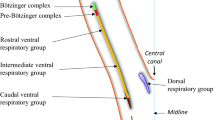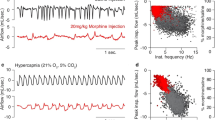Abstract
Pretreatment of the G-protein coupled nociceptin receptor (NOP) with nociceptin/orphaninFQ (N/OFQ) produces desensitisation. The influences of receptor expression and genomic effects are largely unknown. We have used an ecdysone-inducible NOP expression system in a CHO line (CHOINDhNOP) to examine the effects of N/OFQ pretreatment upon receptor density, GTPγ[35S] binding, cAMP formation and NOP-mRNA. CHOINDhNOP induced with 5 and 10 μM PonasteroneA (PonA) for 20 h produced NOP densities (B max) of 194 and 473 fmol. mg-1 protein, respectively. This was accompanied by decreased NOP mRNA. The lower B max is typical of the central nervous system. Pretreatment with 1 μM N/OFQ significantly (p < 0.05) reduced B max at 5 and 10 μM PonA to 100 and 196 fmol. mg-1 protein, respectively. There was no change in binding affinity. Along with the reduction in B max, potency and efficacy for N/OFQ-stimulated GTPγ[35S] binding were also reduced (5 μM PonA: pEC50-control = 8.55 ± 0.06, pretreated = 7.88 ± 0.07; E max-control = 3.52 ± 0.43, pretreated = 2.48 ± 0.10; 10 μM PonA: pEC50-control = 8.41 ± 0.18, pretreated = 7.76 ± 0.03; E max-control = 5.07 ± 0.17, pretreated = 3.38 ± 0.19). For inhibition of cAMP formation, there was a reduction in potency (5 μM PonA: pEC50-control = 9.78 ± 0.08, pretreated = 8.92 ± 0.13; 10 μM PonA: pEC50-control = 9.99 ± 0.07, pretreated = 9.04 ± 0.14), but there was no reduction in efficacy. In addition, there were 39 and 31% reductions in NOP mRNA at 5 and 10 μM PonA, respectively, but these measurements were made following concurrent N/OFQ challenge and PonA induction. In CHOINDhNOP, we have shown a reduction in cell surface receptor numbers and a reduction in functional coupling after N/OFQ pretreatment. This was observed at pseudo-physiological and supraphysiological receptor densities. Moreover, we also report a reduction in NOP mRNA, but further studies are needed which include ‘pulsing’ PonA and desensitizing following wash-out.






Similar content being viewed by others
References
Andressen KW, Norum JH, Levy FO, Krobert KA (2006) Activation of adenylyl cyclase by endogenous G(s)-coupled receptors in human embryonic kidney 293 cells is attenuated by 5-HT(7) receptor expression. Mol Pharmacol 69:207–215
Bailey CP, Connor M (2005) Opioids: cellular mechanisms of tolerance and physical dependence. Curr Opin Pharmacol 5:60–68
Calo G, Guerrini R, Rizzi A, Salvadri S, Regoli D (2000) Pharmacology of nociceptin and its receptor: a novel therapeutic target. Br J Pharmacol 129:1261–1283
Castelli MP, Melis M, Mameli M, Fadda P, Diaz G, Gessa GL (1997) Chronic morphine and naltrexone fail to modify mu-opioid receptor mRNA levels in the rat brain. Brain Res Mol Brain Res 45:149–153
Chavkin C, McLaughlin JP, Celver JP (2001) Regulation of opioid receptor function by chronic agonist exposure: constitutive activity and desensitization. Mol Pharmacol 60:20–25
Cheng ZJ, Fan GH, Zhao J, Zhang Z, Wu YL, Jiang LZ, Zhu Y, Pei G, Ma L (1997) Endogenous opioid receptor-like receptor in human neuroblastoma SK-N-SH cells: activation of inhibitory G protein and homologous desensitization. Neuroreport 8:1913–1918
Connor M, Vaughan CW, Chieng B, Christie MJ (1996) Nociceptin receptor coupling to a potassium conductance in rat locus coeruleus neurones in vitro. Br J Pharmacol 119:1614–1618
Connor M, Osborne PB, Christie MJ (2004) Mu-opioid receptor desensitization: is morphine different? Br J Pharmacol 143:685–696
Gainetdinov RR, Premont RT, Bohn LM, Lefkowitz RJ, Caron MG (2004) Desensitization of G protein-coupled receptors and neuronal functions. Annu Rev Neurosci 27:107–144
Gavioli EC, Calo G (2006) Antidepressant- and anxiolytic-like effects of nociceptin/orphanin FQ receptor ligands. Naunyn. Schmiedebergs Arch Pharmacol 372:319–330
Gintzler AR, Chakrabarti S (2006) Post-opioid receptor adaptations to chronic morphine; altered functionality and associations of signaling molecules. Life Sci 79:717–722
Hashiba E, Harrison C, Galo G, Guerrini R, Rowbotham DJ, Smith G, Lambert DG (2001) Characterisation and comparison of novel ligands for the nociceptin/orphanin FQ receptor. Naunyn. Schmiedebergs Arch Pharmacol 363:28–33
Hashimoto Y, Calo G, Guerrini R, Smith G, Lambert DG (2002) Effects of chronic nociceptin/orphanin FQ exposure on cAMP accumulation and receptor density in Chinese hamster ovary cells expressing human nociceptin/orphanin FQ receptors. Eur J Pharmacol 449:17–22
Hawes BE, Graziano MP, Lambert DG (2000) Cellular actions of nociceptin: transduction mechanisms. Peptides 21:961–967
Johnson EE, Chieng B, Napier I, Connor M (2006) Decreased mu-opioid receptor signalling and a reduction in calcium current density in sensory neurons from chronically morphine-treated mice. Br J Pharmacol 148:947–955
Kim MS, Cheong YP, So HS, Lee KM, Son Y, Lee CS, Yun JS, Park R (2002) Regulation of cyclic AMP-dependent response element-binding protein (CREB) by the nociceptin/orphanin FQ in human dopaminergic SH-SY5Y cells. Biochem Biophys Res Commun 291:663–668
Law PY, Kouhen OM, Solberg J, Wang W, Erickson LJ, Loh HH (2000) Deltorphin II-induced rapid desensitization of delta-opioid receptor requires both phosphorylation and internalization of the receptor. J Biol Chem 275:32057–32065
Ma L, Pei G (2007) Beta-arrestin signaling and regulation of transcription. J Cell Sci 120:213–218
Ma L, Cheng ZJ, Fan GH, Cai YC, Jiang LZ, Pei G (1997) Functional expression, activation and desensitization of opioid receptor-like receptor ORL1 in neuroblastoma x glioma NG108–15 hybrid cells. FEBS Lett 403:91–94
Marie N, Aguila B, Allouche S (2006) Tracking the opioid receptors on the way of desensitization. Cell Signal 18:1815–1833
McDonald J, Barnes TA, Okawa H, Williams J, Calo G, Rowbotham DJ, Lambert DG (2003) Partial agonist behaviour depends upon the level of nociceptin/orphanin FQ receptor expression: studies using the ecdysone-inducible mammalian expression system. Br J Pharmacol 140:61–70
Meunier J (2000) The potential therapeutic value of nociceptin receptor agonists and antagonists. Exp Opin Ther Patents 10:371–388
Meunier JC, Mollereau C, Toll L, Suaudeau C, Moisand C, Alvinerie P, Butour JL, Guillemot JC, Ferrara P, Monsarrat B et al (1995) Isolation and structure of the endogenous agonist of opioid receptor-like ORL1 receptor. Nature 377:532–535
Mogil JS, Pasternak GW (2001) The molecular and behavioral pharmacology of the orphanin FQ/nociceptin peptide and receptor family. Pharmacol Rev 53:381–415
Morikawa H, Fukuda K, Mima H, Shoda T, Kato S, Mori K (1998) Nociceptin receptor-mediated Ca2+ channel inhibition and its desensitization in NG108–15 cells. Eur J Pharmacol 351:247–252
New DC, Wong YH (2002) The ORL1 receptor: molecular pharmacology and signalling mechanisms. Neurosignals 11:197–212
No D, Yao TP, Evans RM (1996) Ecdysone-inducible gene expression in mammalian cells and transgenic mice. Proc Natl Acad Sci USA 93:3346–3351
Oehme I, Bosser S, Zornig M (2006) Agonists of an ecdysone-inducible mammalian expression system inhibit Fas Ligand- and TRAIL-induced apoptosis in the human colon carcinoma cell line RKO. Cell Death Differ 13:189–201
Okawa H, Hirst RA, Smart D, McKnight AT, Lambert DG (1998) Rat central ORL-1 receptor uncouples from adenylyl cyclase during membrane preparation. Neurosci Lett 246:49–52
Pei G, Ling K, Pu L, Cunningham MD, Ma L (1997) Nociceptin/orphanin FQ stimulates extracellular acidification and desensitization of the response involves protein kinase C. FEBS Lett 412:253–256
Reinscheid RK, Nothacker HP, Bourson A, Ardati A, Henningsen RA, Bunzow JR, Grandy DK, Langen H, Monsma FJ, Civelli O (1995) Orphanin FQ: a neuropeptide that activates an opioidlike G protein-coupled receptor. Science 270:792–794
Spampinato S, Di Toro R, Qasem AR (2001) Nociceptin-induced internalization of the ORL1 receptor in human neuroblastoma cells. Neuroreport 12:3159–3163
Spampinato S, Baiula M, Calienni M (2007) Agonist-regulated internalization and desensitization of the human nociceptin receptor expressed in CHO cells. Curr Drug Targets 8:137–146
Thakker DR, Standifer KM (2002) Induction of G protein-coupled receptor kinases 2 and 3 contributes to the cross-talk between mu and ORL1 receptors following prolonged agonist exposure. Neuropharmacology 43:979–990
Violin JD, Dewire SM, Barnes WG, Lefkowitz RJ (2006) G protein-coupled receptor kinase and beta-arrestin-mediated desensitization of the angiotensin II type 1A receptor elucidated by diacylglycerol dynamics. J Biol Chem 281:36411–36419
Wu EH, Lo RK, Wong YH (2003) Regulation of STAT3 activity by G16-coupled receptors. Biochem Biophys Res Commun 303:920–925
Zeilhofer HU, Calo G (2003) Nociceptin/orphanin FQ and its receptor–potential targets for pain therapy? J Pharmacol Exp Ther 306:423–429
Acknowledgements
Supported in part by British Journal of Anaesthesia/Royal College of Anaesthetists and UHL-NHS Trust. We would like to thank Drs. G. Calo and R. Guerrini (University of Ferrara, Italy) for providing N/OFQ.
Conflict of interest stament
We have no conflict of interests to declare.
Author information
Authors and Affiliations
Corresponding author
Rights and permissions
About this article
Cite this article
Barnes, T.A., McDonald, J., Rowbotham, D.J. et al. Effects of receptor density on Nociceptin/OrphaninFQ peptide receptor desensitisation: studies using the ecdysone inducible expression system. Naunyn-Schmied Arch Pharmacol 376, 217–225 (2007). https://doi.org/10.1007/s00210-007-0189-z
Received:
Accepted:
Published:
Issue Date:
DOI: https://doi.org/10.1007/s00210-007-0189-z




